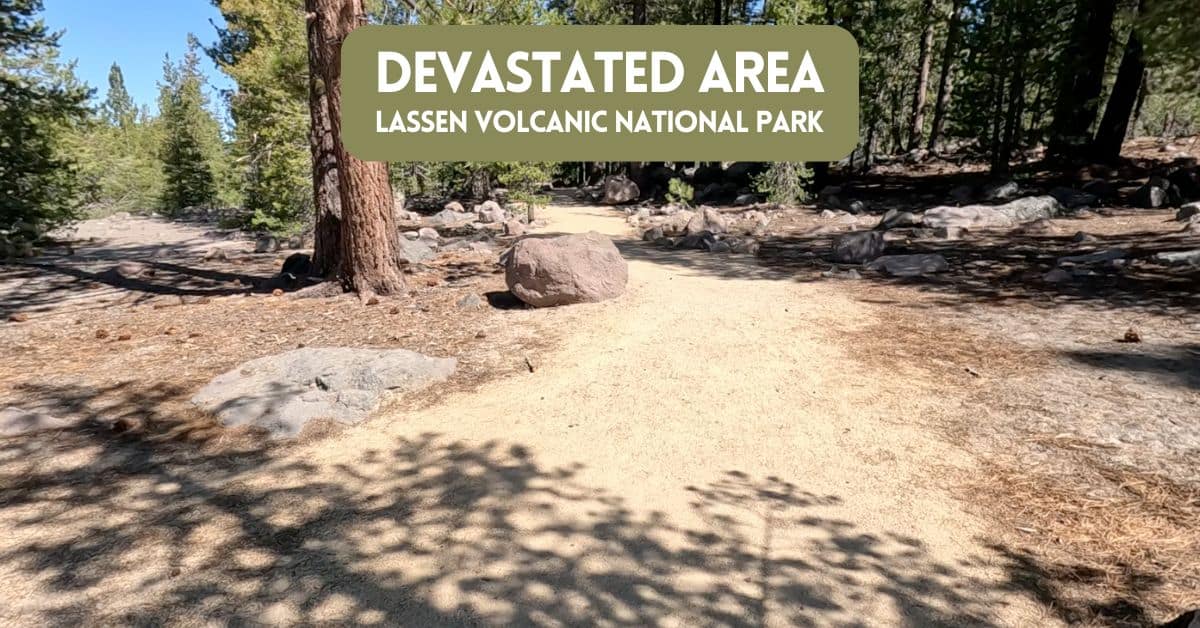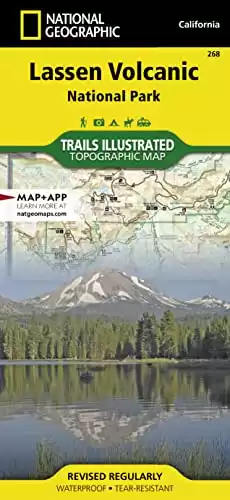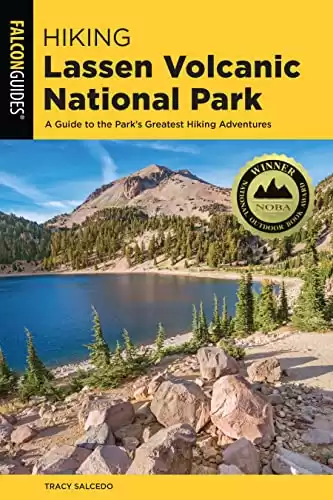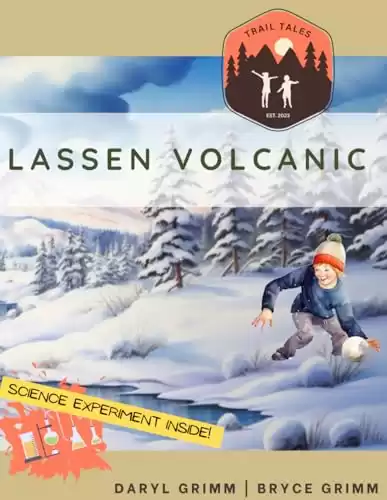Exploring the Devastated Area in Lassen Volcanic National Park
Nature enthusiasts and adventure seekers prepare to be captivated by the raw power of Earth! Nestled in the heart of Northern California, Lassen Volcanic National Park offers a unique glimpse into the fury of volcanic activity and its aftermath. The Devastated Area is one of the park’s most fascinating areas. This blog post will take you on a journey through this extraordinary landscape—exploring its history, geology, and the unforgettable experiences it offers to eco-tourists, adventure enthusiasts, and geology fans alike.
The Places Where We Go contains affiliate links and is a member of the Amazon Services LLC Associates Program. As an Amazon Associate, we earn from qualifying purchases at no extra cost to you when you purchase using one of these Amazon links. Read our disclaimer and privacy policy for more information.
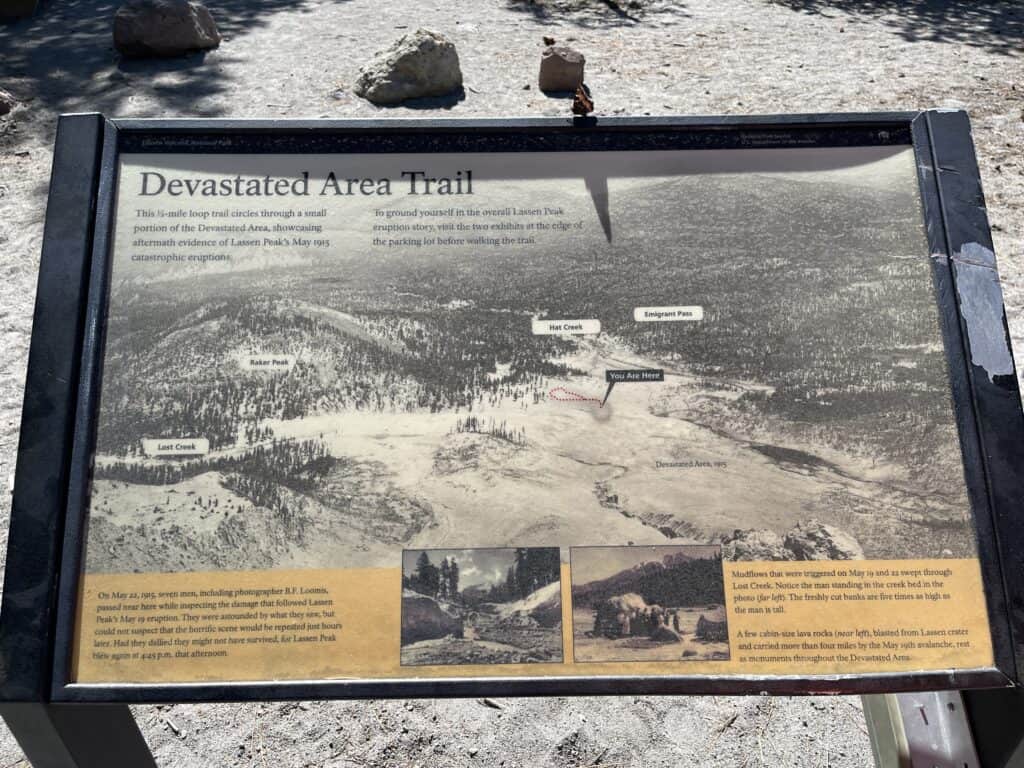
The Historic Eruption that Transformed Lassen
In May 1915, Lassen Peak, one of the largest plug dome volcanoes in the world, erupted with explosive force. This historic event reshaped the landscape, creating what we now call the Devastated Area. The peak eruption was the most significant volcanic event in the contiguous United States until Mount St. Helens blew its top in 1980. For those fascinated by the sheer power of nature, understanding this eruption is key to appreciating the Devastated Area.
The Eruption’s Immediate Impact
The eruption sent a towering column of ash and gas into the sky, raining volcanic debris over miles of surrounding wilderness. Pyroclastic flows and lava bombs barreled down the slopes, obliterating everything in their path. Trees were snapped like matchsticks, and the earth was scorched.
Long-Term Consequences
The eruption’s effects persisted for years. Ash covered the landscape, altering ecosystems and affecting wildlife. Lava flows redirected streams, and new lakes formed in the aftermath. Understanding these long-term impacts provides valuable insights into how volcanic activity shapes our planet.
Witnessing History
Visiting the Devastated Area allows you to witness the lingering evidence of this historic eruption. Scorched earth, fallen trees, and hardened lava flows stand as silent testaments to nature’s raw power.
Get Free Weekly Travel News Updates

Exploring the Devastated Area
The Devastated Area is a must-visit for anyone interested in geology, ecology, or stunning landscapes. This section explores what to expect when visiting this remarkable location.
The Devastated Area is an otherworldly landscape. Its stark beauty —jagged rocks, volcanic bombs, and vast ash fields—powerfully reminds visitors of the forces that shaped it. It is a landscape sculpted by fire.
Flora and Fauna
Despite its name, life has begun to reclaim the Devastated Area. Hardy plant species are starting to take root, and wildlife is gradually returning. Observing this resilience is a humbling experience for eco-tourists and nature lovers.
Points of Interest
The best place to start is on the Devastated Area trail. Be sure to check out the interpretive signs that provide context and historical information. These markers on the interpretive trail help you understand the significance of what you’re seeing and offer a deeper appreciation for the site’s history and geology.
History of the Devastated Area
Understanding the history of the Devastated Area enriches your visit. This section provides a deeper look at the events leading up to the eruption and its aftermath.
Pre-Eruption Lassen
Before the eruption, Lassen Peak was already a towering presence in the landscape. Its long history of smaller eruptions and volcanic activity shaped the region over millennia.
The Eruption Sequence
The 1915 eruption was the climax of a series of smaller eruptions and steam blasts that began in 1914. This build-up created tension and anticipation, culminating in the explosive event that forever changed the region.
Post-Eruption Recovery
In the years following the eruption, nature began its slow recovery process. Studying this recovery offers valuable lessons about ecological resilience and the long-term impacts of volcanic activity.
Getting to the Devastated Area
Planning a visit to the Devastated Area? Here’s what you need to know regarding directions and accessibility to make the most of your trip.
Lassen Volcanic National Park is located in northern California. The Devastated Area is accessible via Highway 89, which is the Lassen Volcanic National Park Highway. Clear signage throughout the park makes it easy to find. You’ll find a parking area near the interpretive trail for this area.
You’ll find accessible parking spaces along with vault toilets at the trailhead.
|
Primary Rating:
4.7
|
Primary Rating:
4.8
|
Primary Rating:
5.0
|
|
$14.95
|
$24.95
|
$12.99
|
Best Times to Visit
The park is open year-round, but summer is the best time to visit the Devastated Area in Lassen Volcanic National Park. Snow can make access difficult in winter, and some parts of the park may be closed.
Check out our post on the best time to visit Lassen Volcanic National Park.
Park Facilities
The park offers a range of facilities, including visitor centers, restrooms, and picnic areas. Be sure to stop by the visitor center for maps, information, and condition updates. On the way to the Devastated Area, you’ll pass by a visitor center near Manzanita Lake.
Time Recommended for Visiting
How much time should you allocate for exploring the Devastated Area? Here’s a guide to help you plan your visit.
Quick Visits
If you’re short on time, a quick visit of 1-2 hours can still be rewarding. You can drive through the area, stopping at key viewpoints and interpretive signs to get a sense of the landscape.
Half-Day Exploration
To fully appreciate the Devastated Area, plan for a half-day visit. This allows time for leisurely walks, photography, and deeper site exploration. Bring a picnic and enjoy a meal surrounded by this unique landscape.
Full-Day Adventure
For the ultimate experience, we recommend spending a half-day in the Devastated Area. Combine your visit with hikes to nearby trails, or join a ranger-led tour for expert insights. A half-day allows you to immerse yourself in this part of the park’s history and beauty.
Is It Safe to Visit?
Safety is a top priority when visiting any natural site. Here’s what you need to know about staying safe in the Devastated Area.
Current Conditions
The National Park Service monitors conditions in the park and provides regular updates. Check the park’s website or visitor center for the latest information on road conditions, weather, and any potential hazards.
General Safety Tips
- Stay on Marked Trails: Straying off the path can be dangerous and damage fragile ecosystems.
- Bring Essentials: Carry water, snacks, and a first aid kit. Because the weather can change rapidly, dress in layers and bring sun protection.
- Wildlife Awareness: Keep a safe distance from wildlife and never feed animals. Bears and other wildlife are active in the park.
Emergency Services
Park rangers are trained and equipped to assist in emergencies. Know the location of the nearest ranger station and have emergency contact numbers handy.
Conclusion
Lassen Volcanic National Park’s Devastated Area offers a unique opportunity to witness the power of volcanic activity and nature’s resilience. Whether you’re an eco-tourist, an adventure seeker, or a geology enthusiast, this extraordinary landscape has something for everyone.
Understanding the area’s history, exploring its features, and following safety guidelines can help you make the most of your visit. Ready to experience the Devastated Area for yourself? Plan your trip today and step into a world shaped by fire and time.
Thanks for reading this article about the Devastated Area at Lassen Volcanic National Park. We hope to see you at the places where we go!
Julie & Art
Explore More About Lassen Volcanic National Park
The best time to visit Lassen Volcanic National Park
Exploring Lassen Volcanic National Park in June

